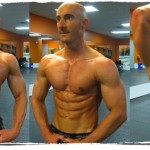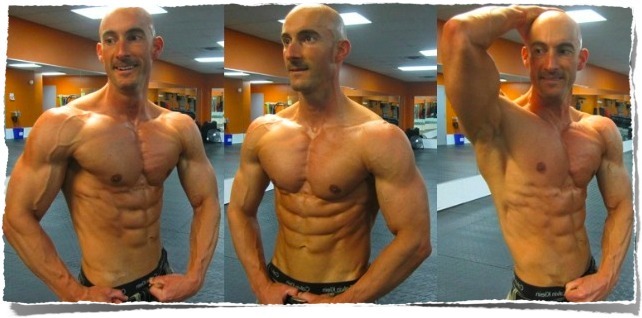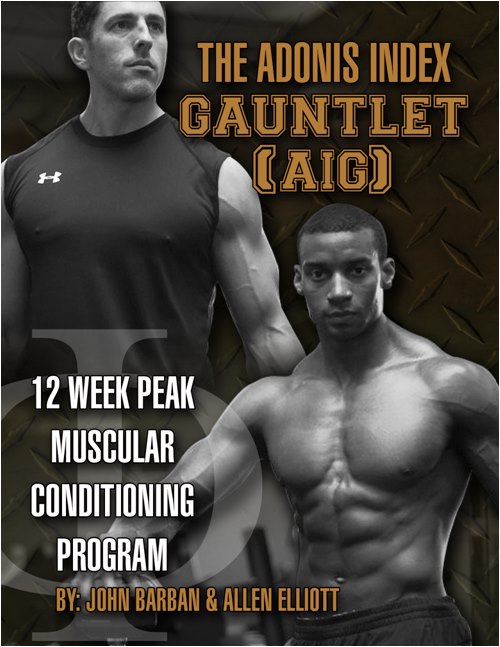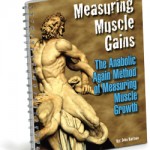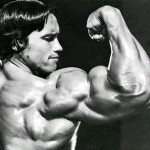Podcast: Play in new window | Download
“State of the Adonis Union” Inaugural Address by Allen Elliott
“The State of The Adonis Union is getting stronger. And we’ve come too far to turn back to the couch.” – Allen Elliott, Adonis Lifestyle Ambassador
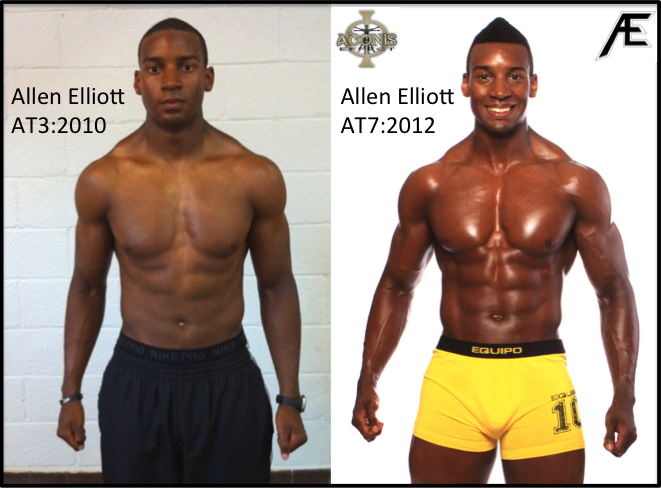
My Adonis Lifestyle Journey began when I made the Watch List in Contest AT3. I received tremendous support from members of the AI/VI community to pursue my fitness endeavors. After winning the AT7 Open Level 2 Contest Category I'm inspired to support and motivate others to begin their own Adonis Lifestyle Journey.
Hello, my name is Allen Elliott and I’d like to share my “Adonis Lifestyle” Story with you. While stumbling upon the Adonis Index website over three years ago, I could’ve never imagined the incredible amount of success and personal satisfaction this system has provided for myself and my fitness endeavors. As an ex-athlete, I’d hear the horror stories’ of guys who started off in great shape only to be de-railed later in life & never recovering. Now that training for performance was no longer a goal or requirement, I was desperately looking for direction. I found the Adonis Index Systems to be straightforward and applicable to anyone desiring to improve their overall “Look” as opposed to specific performance training.
After completing the First Week of Workouts, I took the plunge and never looked back. Training exclusively with Adonis Index Systems, I have competed and placed with top honors in Natural Bodybuilding/ Men’s Physique Fitness Competitions, graced the runway in several prominent fashion shows, and have published work as a fitness model. Following the Adonis Lifestyle has given me unstoppable confidence to pursue my fitness goals with a relentless tenacity.

Allen Elliott | Fitness Model Comp Card || Credits: N3K Photo Studios | Bertron Anderson Photography | Michael Martin Photography
When John contacted me and asked if I would like to become a guest blogger on the site, I was deeply honored and graciously accepted his offer. My Goal while giving back to the Adonis Index Community is to: Supply, Train, and Build.
Supply–As a guest blogger, I will post helpful tips for contest preparation, provide insight on making the transition from an AI Contest to a “Live Show”, and share updates from my Journey in the World of Fitness Modeling.
Train–I’ll also be active in the AI forums to chat with members about training styles, body-part specialization within the AI system, and any other topics that may arise that I can help with.
Build–Preparing for the road ahead, John and myself are masterminding to bring you the next Adonis Index workout. This advanced workout will show you how I prepare for Fitness Competitions and Model Photo-Shoots, Adonis Index Style.
As we carry forward the plans and programs to better help you achieve your fitness goals I’d like to remind you to enjoy your fitness journey, the results are worth the effort. Stay Tuned! The best is yet to come.
Allen Elliott
Eating for Weight Loss Over The Holidays
Notice: This is an oldie but goodie that we’ve pulled up to the front
Eating during the holidays is usually associated with weight gain, but it doesn’t necessarily have to be that way.
You should be able to indulge in big holiday dinners as long as you plan your eating around that dinner accordingly.
As we always say, every up needs a down. So if you’re planning on having a few big christmas feasts at the end of this week, you should take it light on the days leading up to the big meal.
Creating a calorie deficit throughout the week BEFORE you sit down to christmas dinner is a better strategy than waiting till after the holidays to work off the extra calories. <– You and I both know the latter never works.
In this podcast, we’ll talk about eating strategies that can work for weight maintenance and even weight loss over the holidays. We’ll also help you identify when people are trying to hold you back from achieving your lifestyle goals and what to do about it.
John
Podcast: Play in new window | Download
Are You Focused On Local Optimums?
The Weight Loss Research Explained podcast was one of our best yet from a content/eye opening perspective I’d say. So, in the spirit of extending the conversion beyond what we covered in that podcast, I want to expand on something that we touched on briefly.
Focusing on local optimums.
Or in other words, trying to maximize one specific part of your weight loss or muscle building system regardless of it’s effects on your “throughput” or productivity as a whole.
Sounds like high tech mumbo jumbo doesn’t it?
It’s really not.
Let me ask you this.
How many times have you attempted to improve one specific area of your life… and you improve it… only to have it NOT have a profound effect on your life AS A WHOLE?
I know I’ve done it a bunch of times myself.
I’ve tried the eating 6 meals a day to “optimize” my energy and insulin levels.
I’ve done the bouts of interval training to “optimize” my fat burning potential.
I’ve pounded out squats and deads to “optimize” my muscle building hormone profile.
Heck, I’ve even pounded a 6 pack of beer to “optimize” my perceived communication abilities with the ladies… HAHA! (tell me you haven’t).
But guess what?
Not one of these optimizations have gotten me the results I wanted and in fact, once I STOPPED focusing on these local optimums and started to understand what the real goal and the real measurement of that goal was, did I understand exactly WHY I wasn’t getting the results I wanted.
There is a difference in a “controlled” environment and a “free range” environment… and almost all of us operate in a “free range” environment – yet almost all of the advice given in health and fitness today is based on a result from a “controlled” environment
And, it’s tough to translate a result that someone gets in a study… or even with supervised training… which in essence holds one or more important variables in check… when you couple that with the fact that the makeup of YOUR life is completely different than everyone else’s.
All of the variables are different. (notice I said LIFE and not body)
But even personal trainers have a tough time getting people results a lot of the time.
Why?
It’s simple. The trainer or coach only has access or control of 2-4 hours of a person’s time per WEEK. So no matter how optimized the training protocol, which is the area that the trainer has full control over… unless there’s some sort of strategy that addresses all of the other compensating effects, all of the OTHER important variables… then the person being trained may only achieve certain performance improvements, but not the “looks” improvements that they desire.
Here’s an example:
5 or 6 years ago when I was in the health club game, I set up a program with our trainers that was COMPLETELY HARDCORE. It was group training and used a lot of the principles you hear about on most of the fitness blogs out there today.
– intervals
– supersets
– bodyweight exercises
– etc
… but, after 8 weeks, there was one woman that just wasn’t getting ANY results.
Zero.
(And this was the start of me REALLY starting to understand local optimums.)
Why was it that given the SAME workout protocol, could some people get great results, and others get none?
Naturally, I found out my answer as one of my trainers escorted this woman out to her car to get her check for the next months installment of training… and when our client opened the door to her car… imagine my surprise when a floorboard full of McDonald’s wrappers fell out of the car.
No joke.
Now, of course, you’re probably thinking to yourself “Well duh, no wonder she wasn’t getting results” – and you’d be right.
But that’s not the point.
The point is that this woman was convinced that all she needed to do was participate and make sure her “workouts” were “optimized” and the fat would just drip off of her. This is the primary danger of focusing on local optimums. You lose sight of what the “primary driver” of your results really is.
It’s like John pointed out in the podcast. There’s more to the puzzle than just saying something is “best”.
“Best” for who?
“Best” in what situation?
And, what makes it even more difficult is when you allow people to make their own assumptions based on the advice you give, where the biggest assumption is ALWAYS more is better.
If I say one interval session is good… you’ll do 3.
Again, in an effort to maximize this local optimum.
So what’s the real answer?
Simple.
You have to maximize the productivity of the ENTIRE SYSTEM AS A WHOLE!
Here’s a secret:
Maximizing the entire system MAY NOT require you to run ANYTHING at a local optimum!
It’s about CONSISTENCY and COMPETENCE.
Look, we’ve been through 6 iterations of the Adonis Index Systems, and each time, we adjust something due to “free range” conditions.
And because of it, a higher percentage of people are seeing awesome results.
It’s all based on giving you the TOOLS to maximize the productivity of the ENTIRE SYSTEM… not local optimums.
But only YOU can truly do the maximizing… and it’s NOT by us… OR YOU… focusing on running one little teeny part of your life at 100% efficiency.
After all, it’s about building a better life for yourself… and if that’s not the overall end goal, then none of this truly matters.
B
The Muscle Index – Measuring Muscle Gains
Muscle building is probably one of the most misunderstood things in fitness. This lack of understanding is partly why we can fall for scam products and false claims.
As I’ve said before muscles are much more like water balloons than bricks, and the way we build them is much more like inflating a balloon than laying bricks.
Water accounts for over 80% of your muscle volume, and the amount of water you can fit/force into your muscles plays a major role in determining how big you can make them.
The actual protein ‘scaffolding’ of your muscle fibers/cells are what make up the rest.
Weight Training for Muscle Building:
1) It builds more protein so the scaffolding of your muscles cells is larger
2) It forces more water, glycogen and protein into your cells hydrating and filling them with more fluid (pumping them up)
The Slow Leak Theory of Muscle Growth
Your muscles are in a dynamic state of synthesis and degradation. If you don’t workout your muscles will eventually shrink back to their genetically predetermined original size.
In fact, if you don’t move or use your muscles at all (ie: immobilization in a cast or 100% bed rest) they will shrivel away to almost nothing.
The point is that your muscles function on a ‘use it or lose it’ basis. They will always revert back to a smaller size if you don’t force them to get bigger by lifting weights. As soon as you stop lifting weights they will start shrinking again.
Imagine that your muscles are constantly slowly leaking back to their original smaller size, and constant weight training is the only way to keep them pumped up.
How To Measure Muscle Growth
Most supplement ads and fitness sites will talk about gaining ‘pounds’ of muscle. This however is not an accurate way of measuring true changes in muscle mass. You and I could gain 5-8lbs of lean mass in one day simply from eating more food and drinking water. Our lean body mass would increase, our percentage of fat mass would decrease, but our muscle mass would not have changed.
True changes in muscle mass are harder to detect in experienced lifters and therefore there must be a more precise way to measure these changes. I have come up with a new way to measure changes in muscle mass that account for bodyweight and fat mass. This new measurement is called The Muscle Index.
Toxic Calorie Level
We’ll also talk about the Toxic Calorie level and how eating at this level is what causes fat gain, heart disease, diabetes, and other inflammatory disorders. Eating ‘big’ every once in a while isn’t so bad, but eating at your toxic calorie level on a regular basis will overwhelm your body and cause major problems.
In todays audio lesson we’ll talk about the Muscle Index and how to accurately measure changes in muscle mass.
We will also talk about the slow leak theory of muscle and why you must continue to lift weights in order to keep your muscles growing and even to maintain the size you’ve already built.
John
Podcast: Play in new window | Download
